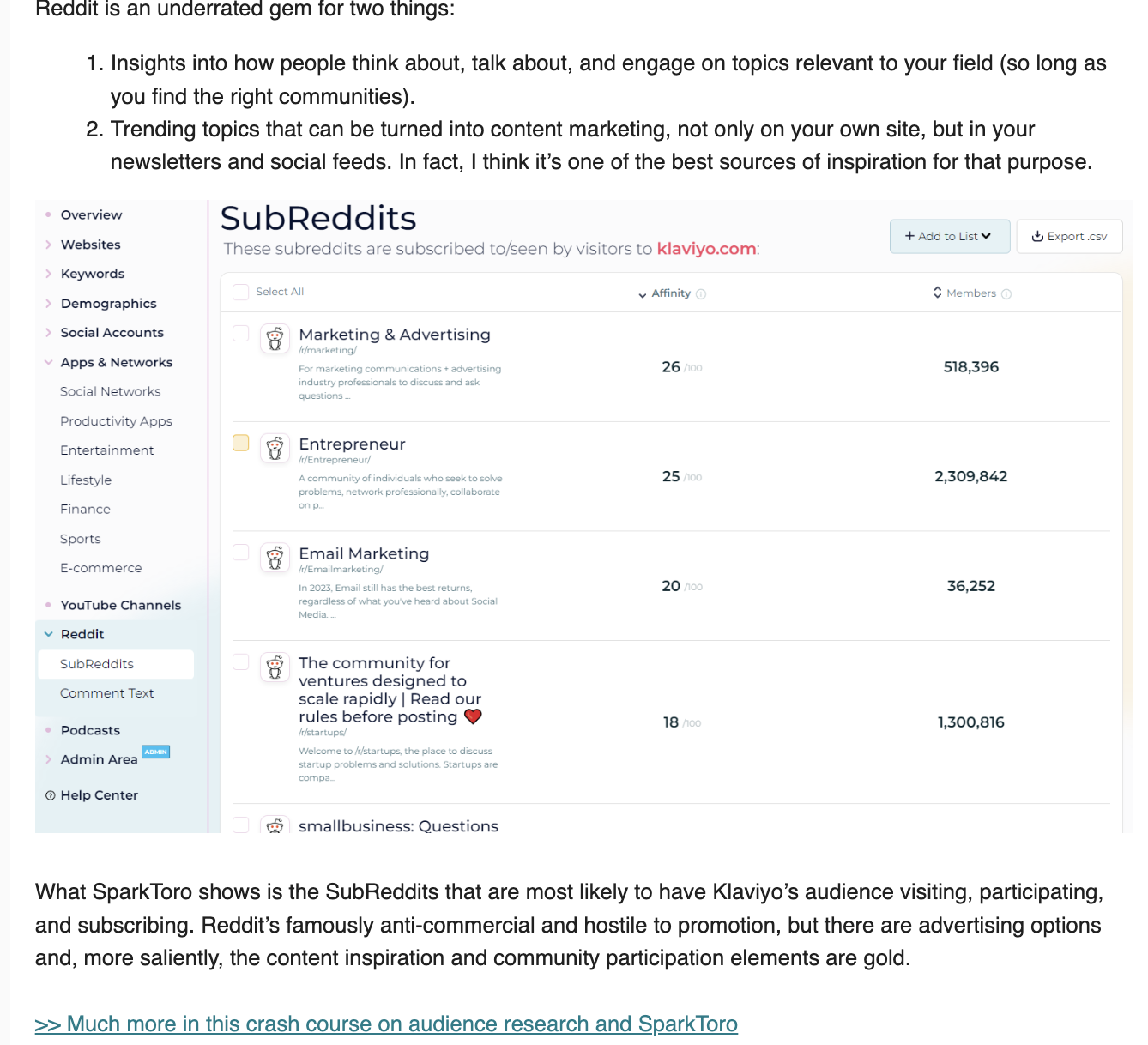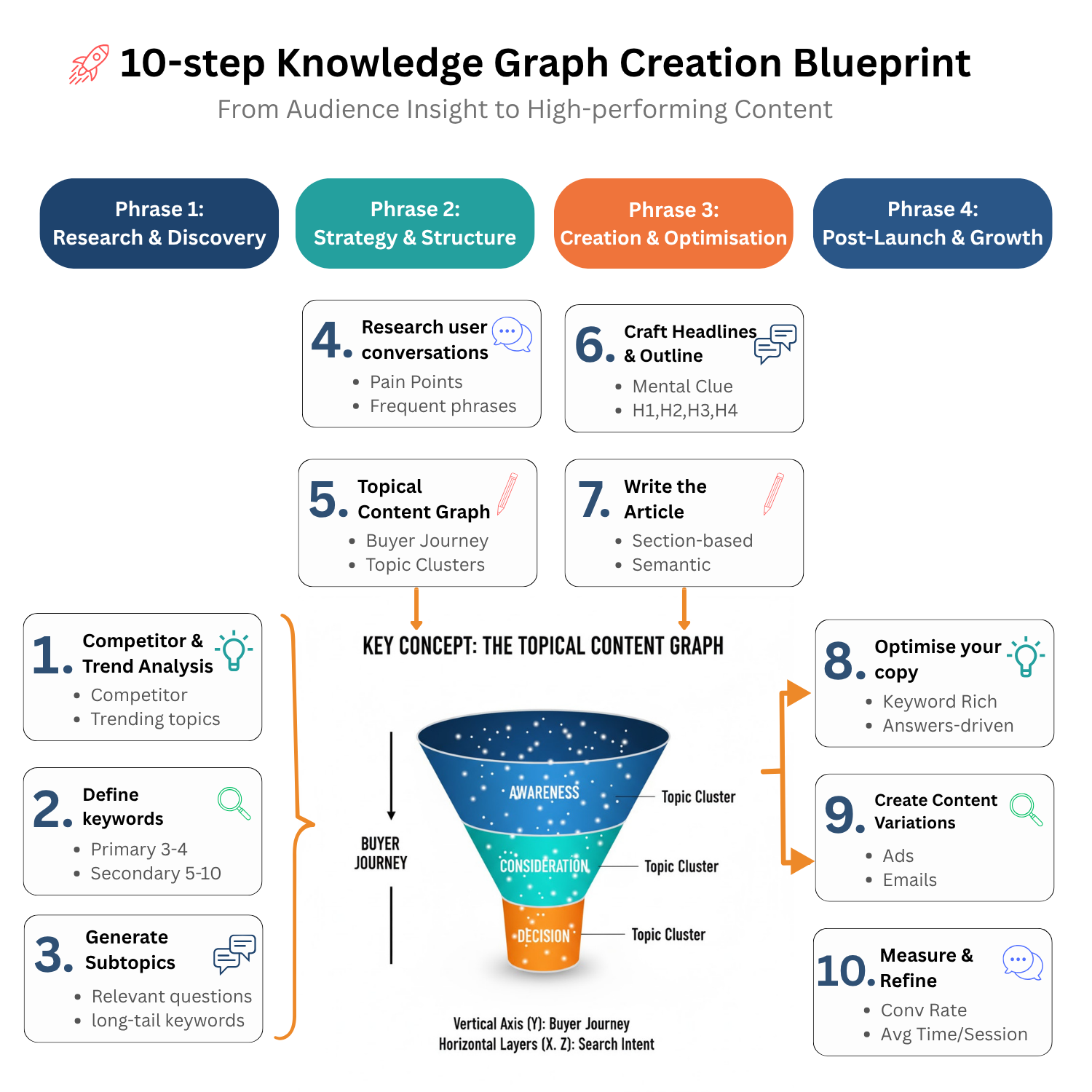Table of Contents (Click to show/hide)









Understanding what your audience wants is the first step in building a winning marketing strategy. If you know their questions, pain points and aspirations, you can create page copy, ads and emails that resonate. To truly capture those questions and pain points, go where your audience already hangs out. Join relevant Facebook or Slack groups (even paid communities) and listen to the raw, unfiltered conversations: how they ask for advice, vent frustrations or celebrate wins. Capture the exact words and phrases they use - both positive and negative, so you can mirror their language in your page copy, ad copy and email copy. Without it, you're flying blind. Audience research helps you tap into the 'Rare' and 'Valuable' elements of your offer – the parts of your product or service that differentiate you from competitors according to the VRIO framework. When you know what makes your offer valuable and rare, you can position your brand strategically to capture market share. This article shows how to leverage Reddit and ChatGPT to conduct deep audience research quickly and build a content strategy that delivers results.
Why Audience Research Matters
Audience research goes beyond guessing what keywords people search for. It’s the starting point for developing your product positioning, page copy, ad copy and email copy. The VRIO framework teaches us that sustainable competitive advantage comes from resources that are Valuable, Rare, Inimitable and Organised. In practice, that means finding the aspects of your offer that customers truly want (valuable), that competitors can’t easily replicate (rare and inimitable) and that you can deliver consistently (organised). Audience research uncovers what your audience cares about and reveals how you can align your unique value with those needs. When you understand the “why” behind a search query, you can write persuasive headlines, create irresistible calls to action and speak directly to the reader’s motives.
Audience research also keeps your messaging fresh. Trends evolve quickly, and words that captivated audiences last year may fall flat today. Social platforms like Reddit and Quora give you a real‑time window into your audience’s conversations. ChatGPT helps you scale your research by structuring topics and keywords based on those conversations. Combine them and you’ll have a robust system for staying ahead of your market.
Competitor & Trend Analysis
Begin with competitor and trend analysis to understand what’s already out there. Look at your competitors’ title tags, meta descriptions and top‑ranking articles. Tools like Google Search’s autocomplete and People Also Ask reveal popular questions users have about your topic. Sites like AlsoAsked.com organise these questions into clusters, while Google Trends shows whether interest in a search term is rising or falling. This initial research helps you spot gaps and opportunities. For example, if competitors focus on broad topics like “content marketing,” you might find a niche by exploring “content marketing for SaaS startups.” Use this data to refine your primary and secondary keywords and to identify angles that haven’t been covered yet.
Note: in Oct 2025, Google's VP of Product answered a question about AEO/GEO for AI Search, addressing what creators should consider. In this SEJ featured article, it points out a very useful idea on how to conquer the content that will get cited by AI and et click:
Reid said, “people want content from that human perspective. They want that sense of like, what’s the unique thing you bring to it, okay? And actually what we see on what people click on, on AI Overviews, is content that is richer and deeper, okay?”
Takeaway:
Publish content that shows original thought, unique insights, and depth rather than echoing what’s already widely said. In my opinion, using software that analyzes the content that’s already ranking or using a skyscraper/10x content strategy is setting yourself up for doing exactly the opposite of what Liz Reid is recommending. A creator will never express a unique insight by echoing what a competitor has already done.
Harnessing ChatGPT for Topic & Keyword Exploration
ChatGPT can dramatically speed up your research once you have a basic understanding of your niche. Use a structured sequence of prompts to generate subtopics and keywords:
1. Generate sub‑topics – Ask: “What are the X most popular sub‑topics related to {Topic}?” This identifies key areas within your niche.
2. Expand on sub‑topics – For each subtopic, ask: “What are the X most popular sub‑topics related to {Sub‑topic}?” This helps you build a hierarchy of related topics.
3. Generate primary keywords – Ask: “List without description the top X most popular keywords for the topic of {Topic}.” This gives you high‑volume keywords.
4. Generate long‑tail keywords – Ask: “List without description the top X most popular long‑tail keywords for the topic {Topic}.” These are more specific queries with lower competition.
5. Generate semantically related keywords – Ask: “List without description the top semantically related keywords and entities for the topic {Topic}.” This uncovers terms that search engines associate with your topic.
6. Combine prompts – Use the “Onion Method” to combine the steps above into a single prompt to save time.
7. Generate questions – Ask: “Generate 10 questions about {Topic}.” Then prompt ChatGPT to refine or expand those questions for different user personas.
8. Alphabet soup method – Ask: “Give me popular keywords that include the keyword ‘SEO’ and the next letter of the alphabet.” Repeat for each letter to find hidden gems.
9. User personas – Ask ChatGPT to generate keywords and questions for each type of persona (e.g., beginners, advanced users) and to list long‑tail keywords to target.
10. Searcher intent – Ask: “For the topic of {Topic}, list 10 keywords for each type of searcher intent (informational, navigational, transactional).” This ensures you cover the funnel.
By following these steps, you’ll build a comprehensive list of keywords and questions that reflect how your audience searches. Keep the results organised in a spreadsheet or use a responsive table generator like the University of Nebraska‑Lincoln’s tool to create mobile‑friendly tables.
While ChatGPT is incredibly useful for exploring topics and keywords (query fan-out), don’t limit yourself to generative AI alone. Broaden your research by digging into user‑generated content platforms such as TikTok Creator Insights, Glimpse and Reddit. These channels reveal trending conversations, pain points and desires that keyword tools miss. Evolve your mindset from purely.
Don’t ignore zero‑volume keywords. Rarely searched phrases often surface in real conversations and can point to emerging trends long before they hit mainstream tools. Dig into tools like People Also Asked and Answer the Public to see what real users ask; skip the simple definition queries and focus on those that reveal pain points, motives and context. These questions are your blueprint for crafting high‑intent headlines, page copy, ad copy and email copy. watch videos, read comments and note the stories people tell. Use those insights to craft more nuanced ChatGPT prompts and build content that speaks directly to what matters most to your audience.
.png)
Unearthing User Insights from Reddit & Quora
Reddit is an under‑rated treasure trove for audience research. Subreddits like r/SEO, r/Entrepreneur or niche communities reveal how real users talk about your topic. Use the search bar to find relevant threads and pay attention to up‑voted comments – these highlight pain points and solutions that resonate. Quora is another valuable resource; its Q&A format exposes questions your audience may be too shy to ask publicly.
Reddit’s anti‑commercial culture means you need to approach research quietly and respectfully. Don’t spam; just observe and take notes. Tools like SparkToro’s “Subreddits” feature can help identify which communities your audience frequents and how engaged they are.

Apply Your Research to Knowledge Graph & Copywriting
Audience research isn’t just for building a list of keywords. It feeds into your copywriting and into building a Topical Content Graph (also called a "Topical Map" or "Semantic Content Graph"). A knowledge graph visualises the relationships between your topics, subtopics, keywords and customer intent. Imagine a three‑dimensional funnel: each horizontal layer is a flat surface covered with scatter dots representing related topics of the same search intent; the vertical axis represents the buyer’s psychological journey from awareness to consideration to decision. This structure helps you organise content by both topic and intent. When you build a Topical Content Graph, you can ensure your site answers user questions at every stage of the funnel and guide readers down a coherent path. This article is Part 1; for a detailed guide on building the graph, see the companion article “Build a Trendy Content Knowledge Graph (Topical Map).”
Audience research also improves copywriting. Once you know what your audience values and the phrases they use, you can craft a **billboard one‑line winner** – a succinct, memorable line that captures the pain point and offers a promise. Use the VRIO insights to highlight the rare and valuable attributes of your offering. For page copy, echo the words users search for and answer their questions directly. For ad copy, use call‑outs that mirror the language of Reddit threads and Quora questions. For email copy, segment your list by persona and search intent, then customise subject lines and body content to address specific needs.
Step‑by‑Step Workflow to Create knowledge Graph

Here is a repeatable process you can follow:
1. Identify competitors and trends – Gather competitor titles, meta descriptions, and trending topics using Google Autocomplete, People Also Ask, AlsoAsked.com, and Google Trends.
2. Define your primary and secondary keywords – Utilise ChatGPT and your tools to select one primary keyword, 3–5 secondary keywords, and 5–10 semantic keywords for your article. Refer to Dean Long’s guide on advanced keyword research for comprehensive instructions.
3. Generate subtopics and questions – Prompt ChatGPT to create a tree of subtopics, long-tail keywords, and relevant questions.
4. Research user conversations – Analyse Reddit and Quora to validate topics, gather language nuances, and identify pain points. Capture quotes and frequent phrases.
5. Build your Topical Content Graph – Use your list of topics, keywords, and questions to visualise a 3D funnel. Organise topics by search intent (awareness, consideration, decision) and map the buyer journey along the vertical axis. Represent individual topics with scatter dots on each layer. Refer to the 3D funnel diagram in Part 2 for a visual example.
6. Craft your headline and outline – Transform your primary keyword into a compelling, benefit-driven headline, considering alliterative or rhyming elements if appropriate. Outline your article with H2 and H3 sections based on subtopics and stages of the buyer journey.
7. Write the article – Develop each section with information from your research. Emphasise key terms in bold and use italics for nuanced points. Incorporate tables or charts to effectively present data.
8. Optimise your copy – Ensure the primary keyword appears in your title, URL, opening paragraph, and headings. Naturally include secondary and semantic keywords throughout the content. Add internal links to related articles and external links to reputable sources.
9. Create variations for ads and emails – Adapt your main headline into different ad headlines and email subject lines. Develop short, medium, and long versions for testing purposes.
10. Measure and refine – Track your article’s search rankings and the keywords that drive traffic. Gather feedback from comments and conversations to update and improve your content.
Conclusion & Next Steps
Audience research is the foundation of any effective SEO and content strategy. By combining ChatGPT’s structured ideation with the raw insights of Reddit and Quora, you can uncover what makes your offer rare and valuable and craft messages that resonate. This process helps you avoid guesswork, write copy that feels personal and design a Topical Content Graph that covers every stage of the buyer journey. In Part 2, we’ll show you how to turn your research into a visual knowledge graph and a scalable content plan that attracts, engages and converts. Meanwhile, start listening to your audience, experiment with ChatGPT prompts and keep refining your approach. When you base your strategy on real insights, your content will stand out in a crowded market.










